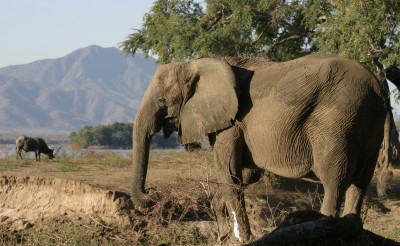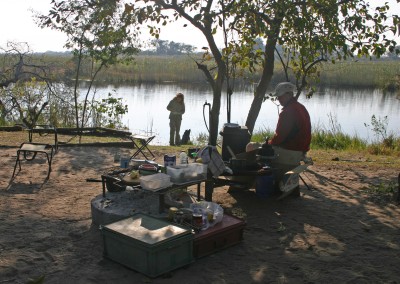We break camp once again and drive as close to Chobe National Park in Botswana as we can. Everything inside the park and in the Okavango Delta has been booked for months, so even though we started planning the trip six months ago there was nothing to find.
Instead, we check into a campsite close to the boring border town of Kasane and set up camp. The most exciting thing about this corner of the world is that you could, in theory, walk from Namibia to Botswana to Zambia to Zimbabwe and back again. In practical terms, though, it would mean queues, visas, permits, fees, rubber stamps, passports and all manner of red tape and bureaucracy.
After setting up our tents, Jørn, Birthe and I go on a game drive in Chobe with a local guide while Mike stays at camp to do whatever he does when he is not waiting on us hand and foot.
During the two hour game drive we see at least 120 elephants, about 20-30 giraffes, and buffalo, hippos, kudu, warthogs, impala, the lovely sable antelope, several stork species, including the ugly Maribou stork and the interesting open-billed stork and lots of other nifty birds.
Next day we hit the road once again and drive to Victoria Falls in Zimbabwe, arriving at our lodge (Yes, lodge! Not tents!) in the afternoon, just in time for a quick bout of sightseeing and shopping in town followed by a cruise on the Zambezi River.
We invite Mike for a luxury dinner buffet that includes ostrich, wild boar and crocodile. The food is scrumptious but the music so loud we can barely talk. There are goodbye hugs, thank yous and that sort of thing before we all head off to bed. Jørn and Birthe will spend a bit more time in Victoria Falls, viewing the waterfalls and so on, while Mike and I will continue onwards in Zimbabwe.
Next morning Mike picks me up at four a.m. sharp (that’s bloody early!) and we drive for five hours straight to get to his house in Bulawayo. Here he switches cars, gets new provisions and packs the car with the assistance of his guiding partner Bernard, whom I have also travelled with before. Meanwhile, I write tons of postcards, wash clothes, read, pick fresh oranges and lemons in Mike’s garden and generally feel quite useless in the midst of the flurry of male activity.
We have travelled 4,200 km. The temperature in my tent has ranged from 7C to 42C. I have had a very close call with a scorpion, heard a very noisy hippo mating and had great times with my friends, enjoying observing their first impressions of Africa. Now is a turning point. New adventures await in Zimbabwe. There will be new people to travel with, new places to see and new animals to meet. Stay tuned!



























































